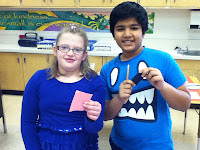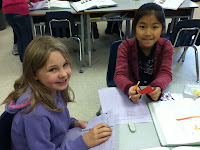We have been doing a creative dance unit in P.E. First, we learned several different hip hop moves (Ms. B sure looked funny trying to dance hip hop with her giant pregnant belly!). Next, Ms. B put some of the steps together to form a short dance which we practiced as a class. Finally, it was our turn to create our own group routines. Below are the videos of our final performances. As you can see we worked hard!
(Note: We aren't a all-girls class! It's just that some of the boys in the boys' dance don't have permission to have their photos on the blog, so their video is not here).
What is your favourite kind of dance to do?
Welcome to Ms. Birdsall's classroom blog. We are a Grade 4 class in Surrey, British Columbia, Canada. We hope that you will enjoy seeing what is happening in our classroom.
Sunday, 17 February 2013
Monday, 11 February 2013
Recipe Testing and Reviewing
In Health and Career Education, we have been studying nutrition. As part of this unit, each student has been asked to find a healthy recipe and try it out at home! After testing the recipe, students need to post the recipe and a review of it on their individual blogs. (Don't forget to write where the recipe came from!) Below is an example of the type of post that would be "fully meeting" expectations. Blog posts must be submitted by Monday, February 18 at 8:00 p.m. Happy cooking!

Wake Up Smoothie
Ingredients
1 1/4 cups orange juice
1 banana
1 1/4 cups frozen berries (such as raspberries, strawberries or blueberries)
1/2 cup low-fat plain yogurt
1 tablespoon sugar (optional)
Put all ingredients in the blender and blend until smooth.
Total time: 5 minutes
Makes: 3 servings, 1 cup each
Recipe from: http://www.eatingwell.com/recipes/wake_up_smoothie.html
My Recipe Review
1) Be careful measuring the ingredients so they don't overflow.
2) Make sure that the blender lid is on tightly before blending or you will have smoothie all over your kitchen!
For the berries, I used strawberries because they are one of my favourite fruits. I loved this smoothie because it tasted sort of like a milkshake, but I know it's healthy for me! My mom and dad liked the taste of it too, and they liked that it was quick to prepare in the morning. They also liked the fact that it was a yummy way of eating more servings of fruit. I would definitely make this recipe again! Next time, I might try adding different kinds of berries.
To add photos to your Kidblog post:
1) Click on "Upload/Insert Media" near the top of the post.
2) Click on "Select Files" in the box that pops up.
3) Choose the folder where your photos are (On my computer I choose "My Documents" then "My Pictures", but it depends where you store your photos).
4) Click on the photo you want to upload, and click "Open".
5) The photo will load. When it's done, click on "Insert into Post" button at the bottom of the page.
6) You can then type above or below the photo to write the rest of your post.
Learning about Area
In Math we have been studying area. Area is the amount of flat space an object takes up. For example, you might measure the area of your living room rug. Area is often measured in square centimetres and square metres.
To help us learn about area we did several activities in class. We played a game with a partner where we needed to create rectangles of different areas based on the product of two dice we rolled. The winner was the person who could fill the larger area of the square centimetre grid.
In teams, we also measured the area of our classroom by creating a newspaper square that measured 1 square metre. (The area was about 65 square metres!)
Finally, we used square tiles to find all the possible rectangles with a given area.
To help us learn about area we did several activities in class. We played a game with a partner where we needed to create rectangles of different areas based on the product of two dice we rolled. The winner was the person who could fill the larger area of the square centimetre grid.
In teams, we also measured the area of our classroom by creating a newspaper square that measured 1 square metre. (The area was about 65 square metres!)
Finally, we used square tiles to find all the possible rectangles with a given area.
Sunday, 3 February 2013
Freerice
On Friday, students were introduced to a terrific on-line game called Freerice. The vocabulary game is easy to play, just click on the correct definition for the given word from four choices. For every word you get right, 10 grains of rice will be donated to the World Food Programme to help feed some of the world's hungriest people. You get smarter, have fun and help others all at the same time! Below are some videos giving more information about the game and where the rice goes when it is donated.
This video is from 2008, so some of the donation numbers they mention are much lower than they are now.
If you haven't played Freerice yet, go give it a try!
First Nations Artifacts
Last week, we were lucky enough to again welcome Richard, one of our district Aboriginal cultural facilitators, into our classroom. This time, he came to teach us about different tools that were commonly used by the First Nations peoples living in this area. He brought in several replicas and we had to hypothesize about what the tool might have been used for. At the end, we shared our hypotheses, then he told us what the tools were actually used for. Many of our guesses were quite accurate! Here are a few photos of us examining the artifacts.
Thank you again, Richard, for sharing your knowledge!
Click here to see the Surrey Schools Aboriginal technology file which shows more pictures and descriptions of tools.
 |
| Projectile points were used for hunting or fishing when attached to an arrow or spear. |
 |
| An abrading stone was used for smoothing materials and keeping knives sharp. |
 |
| An adze was used for scraping, cutting and other woodworking. |
 |
| A biface was used as a knife or as a weapon when attached to a handle. |
 |
| A pebble tool (the oldest artifact) was used for smoothing materials and for hammering. |
 |
| A stone bowl was used for mixing or crushing plants for food or medicine. |
 |
| A maul was used as a hammer. |
 |
| A drill point was used for making holes in bone, stone or animal hides. |
Click here to see the Surrey Schools Aboriginal technology file which shows more pictures and descriptions of tools.
Thursday, 24 January 2013
Transparent, Translucent, Opaque
Currently in Science we are learning about light. In particular, we are focusing on the properties of light. During free experimentation time with our flashlights, we figured out that light always travels in a straight line. Next, we started talking about how light travels through different materials. We learned that objects can be classified into one of three categories:
transparent - you can see through the material clearly because it transmits most light (e.g. a pair of glasses)
translucent - you can see through the material, but it's blurry because the light rays change angles as they go through the material (e.g. a bathroom window)
opaque - you can't see through the material because it absorbs the light (e.g. a book)
To practice our classification skills, Ms. Birdsall divided us into partners and gave us of a bag of objects to identify as transparent, translucent or opaque. The most surprising was the emergency blanket. From a distance it looks opaque (kind of like aluminum foil), but when you look through it up close it's actually translucent!
Wednesday, 23 January 2013
Learning about Cedar
Right now in Social Studies, we are studying the First Nations people of the Pacific Northwest Coast. We are very fortunate to have Aboriginal cultural facilitators in our school district who give presentations to enhance our curriculum. Last week, Richard came into our class to teach us about the importance of the cedar tree to the First Nations people of this area. They called cedar the "Tree of Life" because they used it for so many different things. Objects made out of cedar included: longhouses, canoes, paddles, clothing, baskets, boxes, totem poles, rope, tools and many other items. Here are a few of the things made of cedar that Richard brought to show us.
Next, Richard taught us the process of cedar twining. Traditionally, the First Nations would twine cedar to use as rope. In partners, we twined the cedar to create bracelets. To twine the cedar securely, you first twist a section of the bark, then overlap one part of the bark over the other. The technique takes a bit of practice, but when it's done correctly the rope is very strong. Here we are hard at work.
Thank you Richard for teaching us about cedar!
Next, Richard taught us the process of cedar twining. Traditionally, the First Nations would twine cedar to use as rope. In partners, we twined the cedar to create bracelets. To twine the cedar securely, you first twist a section of the bark, then overlap one part of the bark over the other. The technique takes a bit of practice, but when it's done correctly the rope is very strong. Here we are hard at work.
Thank you Richard for teaching us about cedar!
Monday, 14 January 2013
Light Sources Animotos
In Science, we have been learning about light sources. There are two categories of light sources: natural light and artificial light. Natural light is light that comes from nature, for example, the sun. Artificial light is made by humans, for example, a lamp. To demonstrate their understanding of light sources, students created slideshows using a great program called Animoto. Here are some photos of the students hard at work on the laptops putting together their slideshows.
Here are a couple of examples of the finished Animotos. To see all of the students' slideshows, please click here to visit students individual blogs where the slideshows are posted.
Saturday, 5 January 2013
T'was the Night Before Christmas
Oops, it's a bit late. :-( Nonetheless, I wanted to show off the students' wonderful recitation of the poem, "T'was the Night Before Christmas". Each week we have a "Poem of the Week". In pairs, students usually practice reciting the whole poem to build fluency. However, since this is such a long poem, we divided it into sections, as you'll hear. First, here are a few photos of the students practicing their parts.
Now, click on the link, to hear the poem. listen to ‘T'was the Night Before Christmas’ on Audioboo
Subscribe to:
Posts (Atom)
.jpg)
.jpg)
.jpg)
.jpg)
.jpg)
.jpg)
.jpg)
.jpg)
.jpg)
.jpg)




























